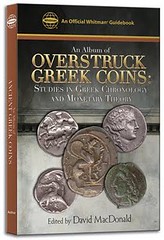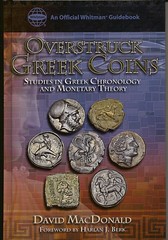
PREV ARTICLE
NEXT ARTICLE
FULL ISSUE
PREV FULL ISSUE
BOOK REVIEW: OVERSTRUCK GREEK COINS BY DAVID MACDONALD
In recent weeks I've been swamped with reader submissions and haven't had time to write up my own. Well, Ed Snible shamed me into it this week with his October 4th blog review of David MacDonald's new Whitman book, Overstruck Greek Coins - Studies in Greek Chronology and Monetary Theory.
First, some excerpts from Ed's review, then some additional thoughts of my own.
-Editor
Ed Snible writes: Although this book is readable it's not intended for beginners. MacDonald doesn't waste a lot of space defining terms that you already know. It's also not a catalog. In the preface it's made clear that the book isn't even trying to list all commonly encountered overstrikes. It's unlikely but possible that catalogers will start including "MacDonald -" when selling overstrikes. This isn't a breathtaking coffee table book listing the highlights of Greek coin art. The coins are nicer than average grade, and often uglier than average. As MacDonald points out Overstruck coins are usually ugly. They are not popular with most collectors and, consequently, are avoided by many dealers. What makes this book wonderful is that the overstruck coins are used to jump into open questions on dating of ancient coins. MacDonald describes simply the currently accepted dating and why it might or must be wrong. He gives enough hints that I could follow the arguments without having to go look up stuff in other books. That's the real strength of this book. In a lot of journal-level numismatic writing the authors are writing towards other PhD classics professors which makes them hard to follow. This book is much smoother. Because only 160 coins are discussed in nearly 300 pages there is enough room to give background on the coins. We get a lot more than who's on the front and a date range like "480-460". Each coin gets a quality discussion which tells us not just the the issue dates, but often tell us which expert proposed the dates and the historical events that begin or close the date range. Note that the cover picture on this post, from Whitman's web site, isn't the cover of the actual book, although they are similar. The fake cover says 'Edited by' David MacDonald. The real cover shows those five coins and two more.
Ed's eyes are sharp, although the "fake cover" found on the Whitman web site is probably an earlier marketing prototype that someone forgot to update. Luckily I have a copy of the real book in hand and scanned the true cover image below (shown to the right of the "fake" cover).
-Editor


To read Ed Snible's review, see: Overstruck Greek Coins (digitalhn.blogspot.com/2009/10/overstruck-greek-coins.html)
I guess I'm one of those beginners who could have used a little more introductory text, but what is there is quite good. I enjoyed reading about the history and use of overstriking and countermarking in the ancient world. My own introduction to the practice came at a talk by Roy Van Ormer at the Western Pennsylvania Numismatic Association many years ago. Roy talked about 19th century counterstamps on U.S. coins, a series I began collecting myself shortly thereafter.
Wayne Homren, Editor The Numismatic Bibliomania Society is a non-profit organization promoting numismatic literature. See our web site at coinbooks.org. To submit items for publication in The E-Sylum, write to the Editor at this address: whomren@gmail.com To subscribe go to: https://my.binhost.com/lists/listinfo/esylum All Rights Reserved. NBS Home Page Contact the NBS webmaster 
|